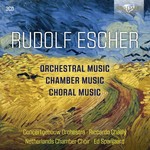
Escher: Orchestral, Chamber and Choral Music
 $30.00
Out of Stock
$30.00
Out of Stock6+ weeks add to cart
RUDOLF ESCHER
Escher: Orchestral, Chamber and Choral Music
Concertgebouw, Riccardo Chailly / Netherlands Chamber Choir
[ Brilliant Classics / 3 CD Box Set ]
Release Date: Friday 10 April 2020
This item is currently out of stock. It may take 6 or more weeks to obtain from when you place your order as this is a specialist product.
The most extensive survey on record of a major Dutch 20th-century composer, featuring some of the country's most distinguished musicians.
Born in 1912, Rudolf Escher had not yet turned 30 when, in the depths of the Second World War, he began the score which would at a stroke make him the most important living composer in the Netherlands. Premiered by the Concertgebouw Orchestra in 1947, Musique pour l'esprit en deuil (1941-3) - 'Music for the grieving spirit' - is a 20-minute score of intense, brooding pathos, inevitably overwhelmed by the shadow of conflict and a worthy counterpart to contemporary works such as Honegger's Liturgique Symphony.
Live recordings conducted by Eduard van Beinum and Bernard Haitink have been published, but this beautifully prepared studio recording is the work of their successor as music director of the Concertgebouw, Riccardo Chailly, who did so much to reconnect the orchestra with the music of our time during his tenure. Musique pour l'esprit en deuil is paired here with the Concerto for String Orchestra (1947-48), which attracted the admiration of John Cage, perhaps more for its surprising points of serenity than its Bartokian passages of tension and exhilarated release.
Choral music occupied a significant place in Escher's fairly slender output. As a teacher and writer on music, a painter and a poet, Escher first thoroughly absorbed the poetry he was setting to music, then carefully devised his treatment of the words to make them both singable and understandable. His choice of poets - Paul Eluard, WH Auden, Emily Dickinson - is notable for its response to text which makes the language new again. The same is true of Ciel, air et vents, a cycle of three songs to words by the 16th-century French poet Pierre Ronsard.
The disc of chamber music opens with Le Tombeau de Ravel, composed in 1952 after Escher's visit to the French composer's house, and laid out as a sequence of oblique Baroque dances in homage to Ravel's own Le Tombeau de Couperin. The two trios that follow - for strings (1959) and for clarinet, viola and piano (1979) - take Escher's tonal idiom to its outer limits while always holding expressiveness and structural control, drama and technique, emotion and intellect in perfect balance.
Rudolf Escher (1912-1980) is without doubt one of the most original, intriguing and successful Dutch composers of the 20th century. In his youth he studied piano, cello, and composition with Willem Pijper in Rotterdam. During the war all his works were destroyed in the Rotterdam bombing. After the war he experimented with electronic music and came into close contact with Pierre Boulez and the serial techniques. In the end Escher developed his own highly personal music language. In Escher's music we hear echos of the Dutch polyphonists, Mahler, Debussy and Ravel. After the war, Escher remained true to his own musical language, never buckling under the force of the latest trend.
This 3-CD portrait of Rudolf Escher presents orchestral works (his famous en best known Musique pour l'Esprit en Deuil and the Concerto for String Orchestra), chamber music (Trio for clarinet, viola and piano, Le Tombeau de Ravel) and Choral music (Songs of Love and Eternity, on poems by Emily Dickinson).
Excellent performances by Dutch forces: Royal Concertgebouw Orchestra/Riccardo Chailly, the Netherlands Chamber Choir and some of the finest Dutch instrumentalists.
This 3-CD set is part of the reissue of the most celebrated recordings from the NM Classics label.